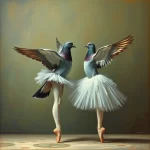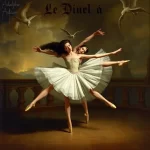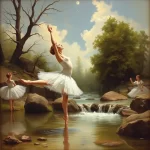Ballet: The Two Pigeons (André Messager, 1886)

Introduction
Ballet, a classical dance form known for its grace and precision, has produced numerous masterpieces over the centuries. One such gem is “The Two Pigeons” (Les Deux Pigeons), a ballet composed by André Messager in 1886. This ballet, choreographed by Louis Mérante, premiered at the Paris Opéra on October 18, 1886. The ballet tells a charming and whimsical story of love, jealousy, and reconciliation, centered around two young lovers and symbolized by the titular pigeons.
Historical Background
Creation and Development
The late 19th century was a period of significant transformation in the world of ballet. The Romantic era had left an indelible mark on the art form, emphasizing emotion, storytelling, and ethereal beauty. “The Two Pigeons” was created in this context, drawing inspiration from the rich tapestry of Romantic ballet traditions. The ballet was inspired by a fable from Jean de La Fontaine, a renowned French poet and fabulist, whose works often explored themes of morality and human nature.
The collaboration between composer André Messager and choreographer Louis Mérante was pivotal in bringing this ballet to life. Messager, a versatile composer known for his operettas and ballets, crafted a score that perfectly complemented Mérante’s choreography. Mérante, a prominent figure in the Paris Opéra, brought his expertise and vision to the project, creating a ballet that was both technically demanding and emotionally resonant.
Premiere and Reception
“The Two Pigeons” premiered at the Paris Opéra on October 18, 1886. The initial reception was overwhelmingly positive, with both critics and audiences praising the ballet for its charming story, beautiful music, and exquisite choreography. The ballet quickly became a staple in the repertoire of the Paris Opéra and was performed regularly in the years following its premiere.
Notable early performances included revivals in major European cities, where the ballet continued to garner acclaim. The combination of Messager’s melodic score and Mérante’s innovative choreography ensured that “The Two Pigeons” remained a beloved work in the ballet canon.
Synopsis of the Ballet
Act I Summary
The ballet opens in a picturesque village where a young painter, Pierre, and his fiancée, Gourouli, are introduced. Pierre is deeply in love with Gourouli, but he is also easily distracted by the allure of adventure and new experiences. The couple’s idyllic life is disrupted when a group of gypsies arrives in the village. Pierre is captivated by the exotic beauty of the gypsy girl, Zizi, and decides to leave Gourouli to join the gypsies on their travels.
Act II Summary
In the second act, Pierre’s infatuation with Zizi leads him into a world of excitement and danger. However, he soon realizes that the gypsy life is not as glamorous as he had imagined. He faces numerous challenges and begins to miss the simplicity and sincerity of his life with Gourouli. Meanwhile, Gourouli, heartbroken by Pierre’s departure, remains in the village, longing for his return.
Finale
The ballet concludes with Pierre’s return to the village. He is filled with remorse for abandoning Gourouli and seeks her forgiveness. The two lovers are reunited, symbolized by the appearance of two pigeons, representing their enduring love and commitment to each other. The ballet ends on a joyful note, with the villagers celebrating the couple’s reconciliation.
Musical Composition
Composer’s Role
André Messager, a prolific composer and conductor, played a crucial role in the creation of “The Two Pigeons.” His score is characterized by its lyrical melodies, rich harmonies, and vibrant orchestration. Messager’s music captures the emotional nuances of the story, from the playful and light-hearted moments to the more dramatic and poignant scenes.
Musical Themes and Motifs
The score of “The Two Pigeons” features several recurring musical themes and motifs that enhance the narrative and emotional depth of the ballet. One of the most notable motifs is the “pigeon theme,” a delicate and lyrical melody that symbolizes the love and connection between Pierre and Gourouli. This theme recurs throughout the ballet, serving as a musical reminder of their bond.
Another significant motif is the “gypsy theme,” characterized by its lively rhythms and exotic harmonies. This theme represents the allure and excitement of the gypsy life that initially captivates Pierre. The contrast between these two themes underscores the central conflict of the ballet and highlights Pierre’s journey of self-discovery and redemption.
Famous Recordings and Performances
Over the years, “The Two Pigeons” has been recorded and performed by numerous orchestras and ballet companies. Notable recordings include those conducted by André Messager himself, as well as more recent interpretations by renowned conductors such as Richard Bonynge and John Lanchbery. These recordings have helped to preserve and popularize Messager’s beautiful score, ensuring that it continues to be enjoyed by audiences around the world.
Choreography and Dance
Choreographer’s Vision
Louis Mérante’s choreography for “The Two Pigeons” is a masterful blend of technical precision and expressive storytelling. Mérante’s vision was to create a ballet that was both entertaining and emotionally resonant, capturing the charm and whimsy of La Fontaine’s fable while also exploring deeper themes of love, jealousy, and forgiveness.
Signature Dance Numbers
One of the standout dance numbers in “The Two Pigeons” is the Pas de Deux between Pierre and Gourouli. This duet is a beautiful expression of their love and connection, featuring intricate lifts, graceful turns, and tender moments of intimacy. Another key dance is the gypsy dance, which showcases the vibrant and energetic choreography that Mérante created to represent the allure of the gypsy life.
Notable Interpretations
Over the years, “The Two Pigeons” has been interpreted and adapted by various choreographers and ballet companies. Each production brings its own unique perspective to the ballet, highlighting different aspects of the story and characters. Notable interpretations include Frederick Ashton’s 1961 revival for The Royal Ballet, which introduced new choreography while staying true to the spirit of the original work.
Characters and Roles
Main Characters
- Pierre: A young painter who is deeply in love with Gourouli but is tempted by the allure of adventure and new experiences.
- Gourouli: Pierre’s fiancée, who remains devoted to him despite his infatuation with the gypsy girl.
- Zizi: A beautiful gypsy girl who captivates Pierre and leads him into a world of excitement and danger.
Supporting Characters
- The Gypsy Leader: The charismatic leader of the gypsy group who welcomes Pierre into their fold.
- The Villagers: The inhabitants of the village who celebrate Pierre and Gourouli’s reunion at the end of the ballet.
Famous Dancers
Over the years, many renowned dancers have portrayed the lead roles in “The Two Pigeons.” Notable performers include Margot Fonteyn and Michael Somes in Frederick Ashton’s 1961 revival, as well as more recent interpretations by dancers such as Alina Cojocaru and Johan Kobborg.
Cultural and Artistic Impact
Influence on Ballet and Dance
“The Two Pigeons” has had a lasting impact on the world of ballet and dance. Its charming story, beautiful music, and innovative choreography have inspired countless choreographers and dancers. The ballet’s themes of love, jealousy, and reconciliation continue to resonate with audiences, making it a timeless work that remains relevant to this day.
Cultural Significance
The ballet’s place in popular culture is also significant. “The Two Pigeons” has been referenced in literature, film, and other art forms, highlighting its enduring appeal. The ballet’s themes and motifs have been adapted and reinterpreted in various ways, ensuring that its legacy continues to be celebrated.
Legacy and Revivals
Major revivals of “The Two Pigeons” have taken place over the years, each bringing new life to the ballet. Frederick Ashton’s 1961 revival for The Royal Ballet is one of the most notable, introducing new choreography while staying true to the spirit of the original work. Modern adaptations and reinterpretations continue to be performed by ballet companies around the world, ensuring that “The Two Pigeons” remains a beloved and celebrated work in the ballet canon.
Iconic Productions
Historic Productions
One of the most famous historical productions of “The Two Pigeons” was the original 1886 premiere at the Paris Opéra. This production featured the choreography of Louis Mérante and the music of André Messager, setting the standard for future performances. Other notable historical productions include early revivals in major European cities, which helped to establish the ballet’s reputation and popularity.
Contemporary Productions
Recent productions of “The Two Pigeons” have continued to captivate audiences with their fresh interpretations and innovative choreography. Contemporary productions often incorporate modern elements while staying true to the essence of the original work. These performances highlight the ballet’s timeless appeal and its ability to resonate with new generations of audiences.
Production Design
The set, costume, and lighting design in various productions of “The Two Pigeons” have played a crucial role in bringing the ballet to life. From the picturesque village setting to the vibrant gypsy camp, the production design helps to create a vivid and immersive world for the audience. Notable designers have contributed to the ballet’s visual appeal, ensuring that each production is a feast for the eyes as well as the ears.
Critical Reception and Reviews
Initial Critical Response
At the time of its premiere, “The Two Pigeons” received overwhelmingly positive reviews from critics. The ballet was praised for its charming story, beautiful music, and exquisite choreography. Critics highlighted the seamless collaboration between Messager and Mérante, noting how their combined talents had created a work of exceptional beauty and emotional depth.
Modern Reviews
Contemporary critics and audiences continue to appreciate “The Two Pigeons” for its timeless appeal and artistic excellence. Modern reviews often highlight the ballet’s enduring themes and its ability to resonate with new generations of viewers. The ballet’s combination of technical precision and expressive storytelling ensures that it remains a beloved work in the ballet repertoire.
Fun Facts and Trivia
Behind-the-Scenes Stories
One interesting anecdote from the production of “The Two Pigeons” involves the use of live pigeons in early performances. These pigeons were trained to fly onto the stage at key moments, adding a touch of realism and charm to the ballet. However, this practice was eventually discontinued due to the unpredictability of the birds’ behavior.
Notable Performers
Over the years, many famous dancers have been associated with “The Two Pigeons.” Margot Fonteyn and Michael Somes are among the most notable, having performed in Frederick Ashton’s 1961 revival. Their performances helped to cement the ballet’s reputation and ensure its continued popularity.
Trivia
- The ballet’s title, “The Two Pigeons,” is a reference to a fable by Jean de La Fontaine, which served as the inspiration for the story.
- André Messager, the composer of the ballet, was also a conductor and served as the music director of the Paris Opéra.
- Frederick Ashton’s 1961 revival of the ballet introduced new choreography while staying true to the spirit of the original work.
Conclusion
Summary of the Ballet’s Importance
“The Two Pigeons” is a significant work in the world of ballet, known for its charming story, beautiful music, and exquisite choreography. The collaboration between André Messager and Louis Mérante resulted in a ballet that has stood the test of time, continuing to captivate audiences with its timeless themes and artistic excellence.
Final Thoughts
Reflecting on “The Two Pigeons,” it is clear that this ballet holds a special place in the hearts of ballet lovers around the world. Its combination of technical precision and expressive storytelling ensures that it remains a beloved work in the ballet repertoire. For those who have not yet experienced this enchanting ballet, I encourage you to watch a performance or listen to the score, and discover the magic of “The Two Pigeons” for yourself.
FAQ
What is the central theme of this ballet?
The central theme of “The Two Pigeons” is love, jealousy, and reconciliation. The ballet explores the journey of two young lovers who are separated by temptation and adventure but ultimately find their way back to each other.
Who are the main characters in this ballet?
The main characters in “The Two Pigeons” are Pierre, a young painter; Gourouli, his fiancée; and Zizi, a beautiful gypsy girl who captivates Pierre.
What is the most famous dance number in this ballet?
One of the most famous dance numbers in “The Two Pigeons” is the Pas de Deux between Pierre and Gourouli, which beautifully expresses their love and connection.
How long does a typical performance of this ballet last?
A typical performance of “The Two Pigeons” lasts approximately 60-70 minutes, depending on the production and any additional intermissions or variations.
Are there any modern adaptations of this ballet?
Yes, there have been several modern adaptations and revivals of “The Two Pigeons,” including Frederick Ashton’s 1961 revival for The Royal Ballet, which introduced new choreography while staying true to the spirit of the original work.
Why is this ballet considered important in the history of dance?
“The Two Pigeons” is considered important in the history of dance due to its charming story, beautiful music, and innovative choreography. The collaboration between André Messager and Louis Mérante resulted in a ballet that has stood the test of time, continuing to captivate audiences with its timeless themes and artistic excellence.





